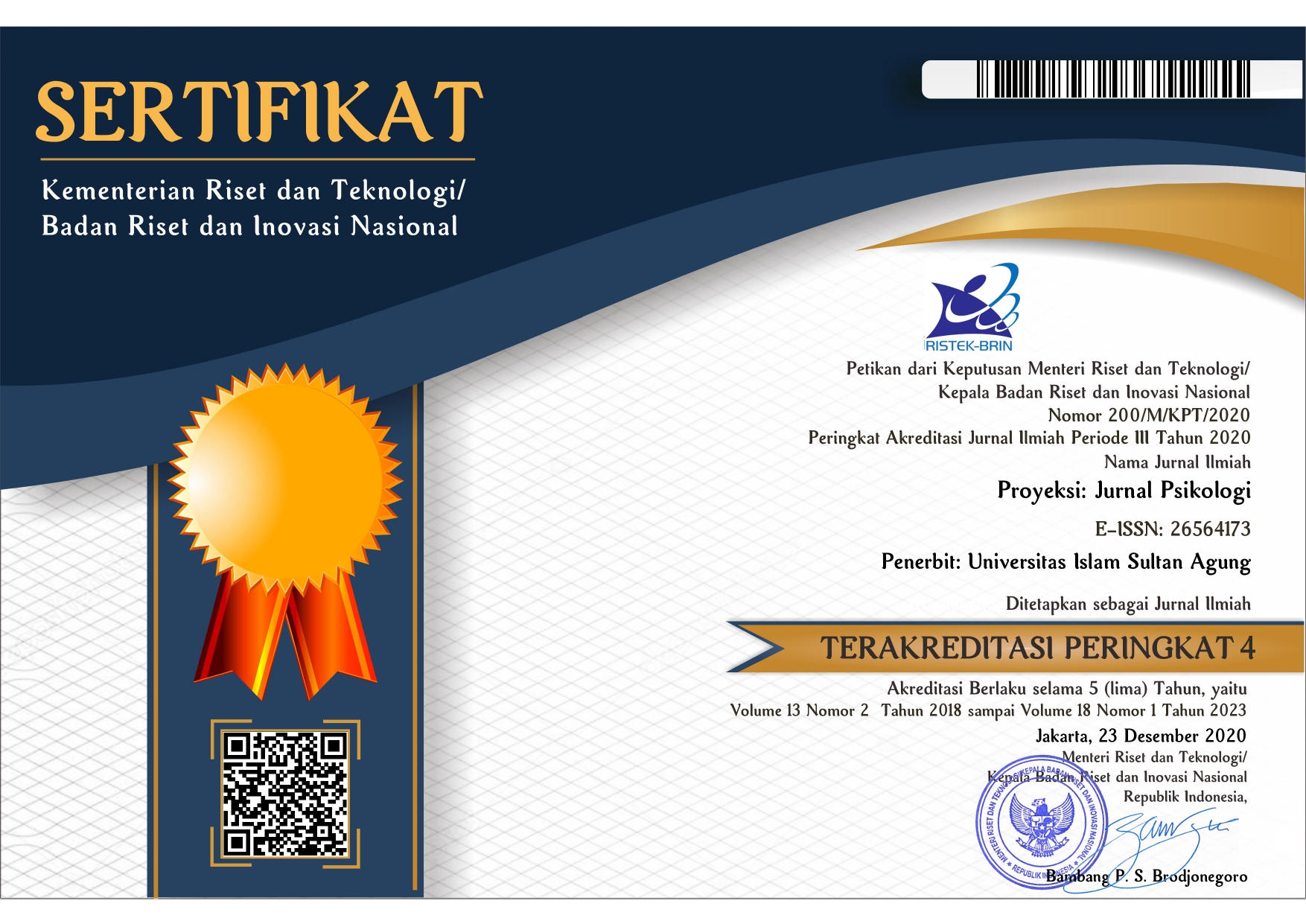BAHAYA BERKOMUNIKASI DI MEDIA SOSIAL
Abstract
instgram. Remaja seolah tanpa hambatan dalam membuka diri melalui status, foto bahkan video tentang diri, di sisi lain remaja kurang mempertimbangkan risiko yang mungkin muncul. Tulisan ini adalah telaah literatur berdasarkan 7 hasil penelitian empiris yang berfokus pada risiko berkomunikasi di media sosial dengan sampel remaja. Tujuan utama telaah literatur ini adalah untuk menjawab 3 pertayaan mendasar yakni: (1) Apa jenis-jenis risiko yang mungkin muncuk terkait dengan komunikasi di media sosial; (2) faktor-faktor apa saja yang mempengaruhi munculnya risiko tersebut; dan (3) Bagaimana cara meminimalisir munculnya risiko berkomunikasi di media sosial. Berdasarkan analisis, eksploitasi seksual, cyberbullying, dan penyalahgunaan data adalah jenis utama risiko yang mungkin muncul. Faktor yang memperbesar munculnya risiko adalah: sifat naif terlalu membuka diri, keterbatasan internet literacy, dan minimnya mediasi orang tua. Lebih lanjut upaya yang bisa dilakukan untuk meminimalisir risiko adalah dengan meningkatkan kesadaran akan privasi dan risiko, meningkatkan internet literacy dan meningkatkan mediasi orang tua. Tulisan ini diharapkan dapat memberikan wawasan serta pijakan bagi penelitian selanjutnya mengenai komunikasi remaja di media sosial.
Keywords
Full Text:
PDFReferences
Affan, H. (2010). Remaja menjadi “korban†Facebook - BBC News Indonesia. Retrieved June 4, 2014, from http://www.bbc.com/indonesia/berita_indonesia/2010/02/100217_facebook
Altman, I. (1977). Privacy Regulation: Culturally Universal or Culturally Specific? Journal of Social Issues, 33(3), 66–84. https://doi.org/10.1111/j.1540-4560.1977.tb01883.x
Bryce, J., & Fraser, J. (2014). The role of disclosure of personal information in the evaluation of risk and trust in young peoples’ online interactions. Computers in Human Behavior, 30, 299–306. https://doi.org/10.1016/j.chb.2013.09.012
Chen, R. (2013). Member use of social networking sites - An empirical examination. Decision Support Systems, 54(3), 1219–1227. https://doi.org/10.1016/j.dss.2012.10.028
Christopherson, K. M. (2007). The positive and negative implications of anonymity in Internet social interactions: “On the Internet, Nobody Knows You’re a Dog.†Computers in Human Behavior, 23(6), 3038–3056. https://doi.org/10.1016/j.chb.2006.09.001
Collins, N. L., & Miller, L. C. (1994). Self - Disclosure and Liking : A Meta - Analytic Review. Psychological Bulletin, 116(3), 457–475. https://doi.org/10.1037//0033-2909.116.3.457
Davis, K. (2012). Tensions of identity in a networked era: Young people’s perspectives on the risks and rewards of online self-expression. New Media & Society, 14, 634–651. https://doi.org/10.1177/1461444811422430
Deci, E. L., & Ryan, R. M. (2000). Psychological Inquiry : An International Journal for the Advancement of Psychological Theory The " What " and " Why " of Goal Pursuits : Human Needs and the Self-Determination of Behavior The “ What †and “ Why †of Goal Pursuits : Human Needs and the Sel. Psychological Inquiry, 11(4), 37–41. https://doi.org/10.1207/S15327965PLI1104
Derlega, V. J., & Chaikin, A. L. (1977). Privacy and Self-Disclosure in Social Relationships. Journal of Social Issues, 33(3), 102–115. https://doi.org/10.1111/j.1540-4560.1977.tb01885.x
Hasinoff, A. A. (2013). Sexting as media production: Rethinking social media and sexuality. New Media and Society, 15(4), 449–465. https://doi.org/10.1177/1461444812459171
Joinson, A. N. (2001). Self-disclosure in computer-mediated communication: the role of self-awereness and visual anonymity. European Journal of Social Psychology, 192(31), 177–192.
Jourard, S. M., & Lasakow, P. (1958). Some factors in self-disclosure. The Journal of Abnormal and Social Psychology, 56(1), 91–98. https://doi.org/10.1037/h0043357
Keipi, T., & Oksanen, A. (2014). Self-exploration, anonymity and risks in the online setting: analysis of narratives by 14–18-year olds. Journal of Youth Studies, 17(8), 1097–1113. https://doi.org/10.1080/13676261.2014.881988
Lee, E. B. (2012). Young, Black, and Connected. Journal of Black Studies, 43(3), 336–354. https://doi.org/10.1177/0021934711425044
Lee, S.-J., & Chae, Y.-G. (2012). Balancing Participation and Risks in Children’s Internet Use: The Role of Internet Literacy and Parental Mediation. Cyberpsychology, Behavior, and Social Networking, 15(5), 257–262. https://doi.org/10.1089/cyber.2011.0552
Leung, L. (2002). Loneliness, Self-Disclosure, and ICQ (“I Seek Youâ€) Use. CYBERPSYCHOLOGY & BEHAVIOR, 5(3), 241–251.
Liu, C., Ang, R. P. R. P. R. P., & Lwin, M. O. M. O. M. O. M. O. (2013). Cognitive, personality, and social factors associated with adolescents’ online personal information disclosure. Journal of Adolescence, 36(4), 629–638. https://doi.org/10.1016/j.adolescence.2013.03.016
Livingstone, S. (2008). Taking risky opportunities in youthful content creation: Teenagers’ use of social networking sites for intimacy, privacy and self-expression. New Media & Society, 10(3), 393–411. https://doi.org/10.1177/1461444808089415
Lwin, M. O., Stanaland, A. J. S., & Miyazaki, A. D. (2008). Protecting children’s privacy online: How parental mediation strategies affect website safeguard effectiveness. Journal of Retailing, 84(2), 205–217. https://doi.org/10.1016/j.jretai.2008.04.004
Mitchell, K. J., Finkelhor, D., & Wolak, J. (2007). Youth Internet Users at Risk for the Most Serious Online Sexual Solicitations, 32(6). https://doi.org/10.1016/j.amepre.2007.02.001
Nasuha. (2011). Akibat jejaring sosial remaja hilang. Retrieved June 4, 2014, from https://www.antarariau.com/berita/16594/akibat-jejaring-sosial-remaja-hilang
Panji, A. (2014). Hasil Survei Pemakaian Internet Remaja Indonesia - Kompas.com. Retrieved May 4, 2014, from https://tekno.kompas.com/read/2014/02/19/1623250/Hasil.Survei.Pemakaian.Internet.Remaja.Indonesia
Staksrud, E., Ólafsson, K., & Livingstone, S. (2013). Does the use of social networking sites increase children’s risk of harm? Computers in Human Behavior, 29(1), 40–50. https://doi.org/10.1016/j.chb.2012.05.026
Stern, S. R. (2002). Virtually Speaking: Girls’ Self-Disclosure on the WWW. Women’s Studies in Communication, 25(2), 223–253. https://doi.org/10.1080/07491409.2002.10162447
Suler, J. (2004). The Online Disinhibition Effect. CyberPsychology & Behavior, 7(3), 321–326. https://doi.org/10.1089/1094931041291295
Valkenburg, P. M., Piotrowski, J. T., Hermanns, J., & de Leeuw, R. (2013). Developing and validating the perceived parental media mediation scale: A self-determination perspective. Human Communication Research, 39(4), 445–469. https://doi.org/10.1111/hcre.12010
Valkenburg, P. M., Sumter, S. R., & Peter, J. (2011). Gender differences in online and offline self-disclosure in pre-adolescence and adolescence. The British Journal of Developmental Psychology, 29(2), 253–269. https://doi.org/10.1348/2044-835X.002001
Warren, R. (2001). In words and deeds: parental involvement and mediation of children’s television viewing. The Journal of Family Communication, 1(4), 211–231. https://doi.org/10.1207/S15327698JFC0104
DOI: http://dx.doi.org/10.30659/jp.9.2.91-103
Refbacks
- There are currently no refbacks.

Proyeksi by http://jurnal.unissula.ac.id/index.php/proyeksi/ is licensed under a Creative Commons Attribution-ShareAlike 4.0 International License.

